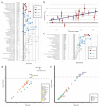Genome-wide association study of intracranial aneurysms identifies 17 risk loci and genetic overlap with clinical risk factors
- PMID: 33199917
- PMCID: PMC7116530
- DOI: 10.1038/s41588-020-00725-7
Genome-wide association study of intracranial aneurysms identifies 17 risk loci and genetic overlap with clinical risk factors
Erratum in
-
Author Correction: Genome-wide association study of intracranial aneurysms identifies 17 risk loci and genetic overlap with clinical risk factors.Nat Genet. 2021 Feb;53(2):254. doi: 10.1038/s41588-020-00760-4. Nat Genet. 2021. PMID: 33353957 No abstract available.
Abstract
Rupture of an intracranial aneurysm leads to subarachnoid hemorrhage, a severe type of stroke. To discover new risk loci and the genetic architecture of intracranial aneurysms, we performed a cross-ancestry, genome-wide association study in 10,754 cases and 306,882 controls of European and East Asian ancestry. We discovered 17 risk loci, 11 of which are new. We reveal a polygenic architecture and explain over half of the disease heritability. We show a high genetic correlation between ruptured and unruptured intracranial aneurysms. We also find a suggestive role for endothelial cells by using gene mapping and heritability enrichment. Drug-target enrichment shows pleiotropy between intracranial aneurysms and antiepileptic and sex hormone drugs, providing insights into intracranial aneurysm pathophysiology. Finally, genetic risks for smoking and high blood pressure, the two main clinical risk factors, play important roles in intracranial aneurysm risk, and drive most of the genetic correlation between intracranial aneurysms and other cerebrovascular traits.
Trial registration: ClinicalTrials.gov NCT02848495.
Conflict of interest statement
When this study was conducted, C.L.M.S. was chief scientist for the UK Biobank study.
Figures



References
-
- Vlak MH, Algra A, Brandenburg R, Rinkel GJ. Prevalence of unruptured intracranial aneurysms, with emphasis on sex, age, comorbidity, country, and time period: a systematic review and meta-analysis. Lancet Neurol. 2011;10:626–36. - PubMed
-
- Nieuwkamp DJ, et al. Changes in case fatality of aneurysmal subarachnoid haemorrhage over time, according to age, sex, and region: a meta-analysis. Lancet Neurol. 2009;8:635–42. - PubMed
-
- Korja M, et al. Genetic epidemiology of spontaneous subarachnoid hemorrhage: Nordic Twin Study. Stroke. 2010;41:2458–62. - PubMed
Publication types
MeSH terms
Associated data
Grants and funding
- MC_U137686851/MRC_/Medical Research Council/United Kingdom
- 212946/Z/18/Z/WT_/Wellcome Trust/United Kingdom
- BHF_/British Heart Foundation/United Kingdom
- MC_QA137853/MRC_/Medical Research Council/United Kingdom
- DH_/Department of Health/United Kingdom
- MC_UU_00017/1/MRC_/Medical Research Council/United Kingdom
- R01 NS034949/NS/NINDS NIH HHS/United States
- MC_PC_17228/MRC_/Medical Research Council/United Kingdom
- CRUK_/Cancer Research UK/United Kingdom
- MC_UU_12026/2/MRC_/Medical Research Council/United Kingdom
- 202922/WT_/Wellcome Trust/United Kingdom
- 202922/Z/16/Z/WT_/Wellcome Trust/United Kingdom
- MC-PC-14135/MRC_/Medical Research Council/United Kingdom
- MC_PC_14135/MRC_/Medical Research Council/United Kingdom
- CIHR/Canada
- MC_PC_13049/MRC_/Medical Research Council/United Kingdom
- 088158/Z/09/Z/WT_/Wellcome Trust/United Kingdom
- 104085/Z/14/Z/WT_/Wellcome Trust/United Kingdom
- MR/S004130/1/MRC_/Medical Research Council/United Kingdom
- 088158/WT_/Wellcome Trust/United Kingdom
- 104085/WT_/Wellcome Trust/United Kingdom

